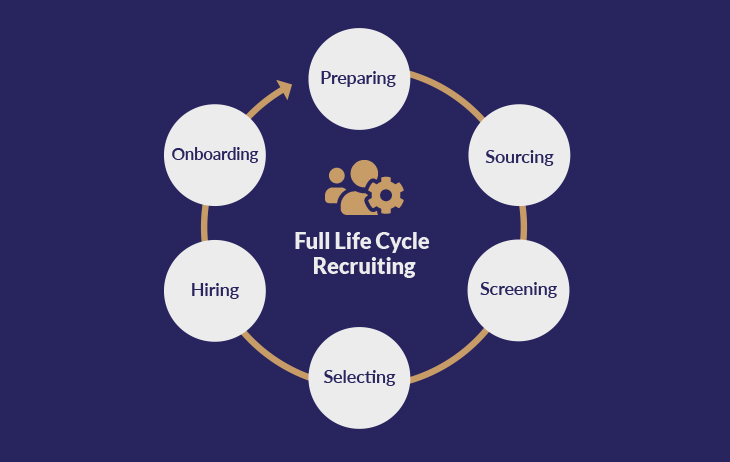Topics: Full Cycle Recruiting, life cycle recruiting, Recruitment Strategy, RPO
The Key Elements of a Successful Full Cycle Recruiting Strategy
Posted on January 11, 2023
Written By
Aanchal Jain

Full cycle recruiting encompasses the most important recruitment processes that directly impact hiring quality and productivity. Poor hiring results in a loss of time, resources, and recruiting team’s productivity. It is essential to have a recruitment strategy plan in place based on a careful job market analysis. Recruiting is not simply about posting a job requirement and interviewing candidates. In today’s candidate-drive labor market, several elements impact the success of recruitment processes which include factors such as candidate experience and employer branding.
Recruitment Process Outsourcing (RPO) is a great way to implement a successful recruitment strategy and make life cycle recruiting more effective. But before you consider offshore RPO services, let’s look at the key elements of a full cycle recruiting strategy that can enable you to hire the best talent and grow your business.
How to make Full Cycle Recruiting successful?
- Positive Candidate Experience
A key element of life cycle recruiting is candidate experience. The recruitment process involves a two-way interaction between the recruiters and applicants. While recruiters or hiring managers evaluate an applicant, the candidate also evaluates an employer before accepting or rejecting the job offer. Providing a positive candidate experience plays a major role in increasing the chances of offer acceptance by potential candidates.
A good recruitment strategy considers candidate experience as a crucial element for success and aims at making it easy, clear, prompt, and enjoyable throughout the full cycle recruiting process (job posting to onboarding). Communication is the key to ensuring positive outreach. Accurate, detailed information should be provided to the candidates regarding the role, salary expectations, and career growth. Candidates should be given timely information regarding the selection process, timing, and prompt feedback on their selection or interview. Cordial and positive engagement with applicants helps recruiters develop a strong talent pipeline even in the case when applicants are not selected.
- Employer Branding
The employer’s brand image is an important element affecting a candidate’s decision-making. Many times, the company’s name and reputation are more valuable for applicants than other stats, job descriptions, perks, etc. The place of employment is a matter of pride for workers and people are more interested in joining organizations with business values aligned with their own.
To attract top talent, a company needs to build a strong employer brand and market it as a great place to work by clearly communicating employee benefits, extracurricular values, annual perks, and other favorable policies. Throughout the various stages of full cycle recruiting, potential candidates should know why your company is the best place for them to work.
- Sourcing and Screening
Proactively sourcing candidates is a great way to find and recruit top talent. Instead of waiting for suitable candidates to find your company and apply for the vacancy, it is better to reach out to them with the help of various talent sourcing techniques. If your company does not have the required resources to source candidates, hiring the services of recruitment process outsourcing (RPO) companies can be helpful. Professional offshore RPO providers have a wide network of candidates and the expertise to find the best talent quickly. A good recruitment strategy encourages using alternative sourcing channels such as employee referrals and professional networks to find the right talent quickly.
Screening candidates is also an essential element of the recruitment strategy plan having a direct impact on its success. Screening starts after sourcing when recruiters have collected candidates’ resumes and need to screen them for the right skills, education, and work experience. An applicant tracking system (ATS) makes the screening process more effective by keeping track of the candidates and maintaining a steady flow of communication with the prospective candidates.
- Workforce Planning
Workforce planning is an intrinsic element of a sound recruitment strategy. Companies should identify their long-term and short-term hiring needs, analyze the employee base strategy regularly and plan their workforce requirements for scaling business capacity. Understanding the workforce requirements leads to better decision-making. Planning will help businesses identify the need for a permanent or temporary workforce allowing them to prioritize resources and make smarter investments.
The work environment has changed drastically post the Covid-19 pandemic with remote working and global hiring opportunities offering new dimensions of flexibility to the workforce. Incorporating such elements into your recruitment strategy can ensure its success in the long term and also improve employee retention.
- Using Different Selection Methods
Selection is one of the most crucial stages of full-cycle recruiting helping recruiters to determine the most suitable candidate for an open vacancy. Screening should therefore be done carefully and using a wide range of methods and selection tools available. An initial screening is used to source suitable CVs and applications which may include screening portfolios, demos, or answers to application questions. Other methods to aid the selection process include skill and competency-based interviews, psychometric analysis, aptitude tests, assessments, and work sampling to name a few.
Book a Consultation
We hope you enjoyed reading this blog. If you want our team to help you resolve talent gaps, reduce costs and transform your business operations, just book a call.
Originally published Jan 11, 2023 05:01:19, updated Feb 05 2024
Topics: Full Cycle Recruiting, life cycle recruiting, Recruitment Strategy, RPO








